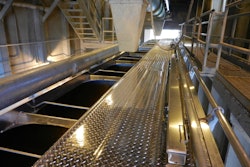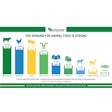
Feed producers have long been interested in knowing that the grain they buy from elevators is safe and within federal guidelines for mycotoxins. But the new rules under the Food and Drug Administration’s Food Safety Modernization Act (FSMA) will likely put more emphasis on elevators for more testing and record keeping.
FSMA rules that go into effect over the next three-plus years don’t change FDA guidance concerning safe levels of mycotoxins, specifically aflatoxin, deoxynivalenol (vomitoxin) and fumonisin. FDA’s action levels and advisory levels for the toxins are different based on the grain’s intended use. Mycotoxins, the product of some fungi that can grow on grain in certain conditions, can cause illness or death in animals that eat tainted feed.
What will change are the requirements for documenting the supply chain and the processes for identifying hazards and preventive control measures. While the onus of that falls on feed producers, they’ll likely look to upstream players for assurance that the products have been tested and deemed safe before arriving at their facilities. Industry experts believe that will mean more testing, and better testing, as well as change in record keeping, for elevators.
“As grain and grain products move through the supply chain, buyers and sellers need to be aware of the relevant regulatory guidance and tolerance limits established for food safety that are associated with the product’s intended use,” says Dave Fairfield, senior vice president of feed services for the National Grain and Feed Association. “Grain elevators, if all they do is receive, store and distribute grain, are exempt from the FDA’s preventive control regulations. That said, the effects of FSMA are going to ripple through the supply chain, whether a given facility in that supply chain is directly regulated or not.”
FSMA will require feed producers to develop food safety plans with hazard analyses that detail each known or foreseeable biological, chemical and physical hazard that could be present in a facility. These could be naturally occurring, unintentionally introduced or intentionally introduced for economic gain.
If the hazard is serious and common enough, feed producers would need to develop preventive controls. That would include process and sanitation controls, as well as supply-chain controls and a recall plan. It would require multiple levels of monitoring procedures, validations and verifications.
In some places, mycotoxins will surely be hazards, and depending on the location, could require preventive controls.
“Facilities will need to consider whether mycotoxins are a hazard of concern for them, and if so how they’re going to manage it and whether they need a preventive control. In a given market area, where growing conditions are not conducive for mycotoxins, it would be unlikely that a facility that conducts a hazard analysis would find a need to have a preventive control for mycotoxins,” Fairfield says. “A given facility’s evaluation about how mycotoxins should be handled within their food safety plan could change based upon the growing season in their market or the markets where they source grain.”
Testing issues
To be sure, elevators are already testing grain for mycotoxins and have been for a long time. But the attention to detail in testing and record keeping will likely become more serious for some operations.
“Any processor that accepts grain from a facility accepts all risks associated with that grain,” says Erin Bowers, a research associate at Iowa State University. “Even though elevators aren’t directly covered, there still is going to be some pushback throughout the industry so that nobody is taking some liability they aren’t ready for.”
Bowers adds that the time it can take to thoroughly inspect a delivery can seriously slow down operations at an elevator, to the point at which some places simply cut back on testing.
“In many areas of the U.S., there has not been an economic reason to test, so it’s been very sporadic,” Bowers says. “It’s harvesttime, so you have 20 trucks lined up to dump, and if you want to obtain a representative sample and do a mycotoxin test on every truck, you have to take multiple probes of grain from different areas within the truck to acquire a 10-pound sample, grind that whole 10 pounds of corn, get a sub sample out of that ground grain, and perform a rapid test. That whole process took you 20 minutes, and what happened to those other 20 trucks that were waiting?”
But that screening is just too important, says Pat Frasco, director of the milling and grain division at Neogen, an international food safety company based in Lansing, MI, that produces mycotoxin testing kits.
“The days of ignoring it or saying ‘we don’t have a problem here because we’ve never had a problem’ are in the past,” he says. “What I say to my customers is as a grain elevator, you may not be required to test for mycotoxins, but if you want to be seen as a reliable and consistent supplier, you should strongly consider looking at a robust testing protocol.”
Frasco says under FSMA, taking a chance on mycotoxins is just too big a risk.
“I have an appreciation for what the grain elevators and the receiving points have to go through. Having said that, if you don’t have a robust sampling method and testing procedure, once that grain is dumped it is going to get commingled,” he says. “If you don’t have a good testing program on the front end, you’re really gambling with what you’ll have coming out the back end.”
Issues can also arise when elevators simply don’t run into mycotoxin issues regularly. It can make them complacent.
“Elevators are aware of it, but they’re not always prepared for it, especially when you don’t have to manage the situation every single year. You don’t have the preparation or the practice to be good at it,” says Patricia Jackson, market development manager at VICAM, a mycotoxin testing company based in Milford, MA.
In those, and other, cases, Jackson says unfamiliarity with running a test can cause problems. Grain must be ground and weighed correctly, and measurements made for tests are key.
“Attention to detail is important in terms of measuring your sample weight, solution, proper pipetting — you’re dealing with such tiny concentrations of toxins, that even tiny fluctuations in your sample can make a difference in the results of your tests,” she says. “If you measure too much methanol and water, you’ll still have the toxin in the solution, but it will be too diluted. And if you have too little, the result will be too high. Every measurement you take when you are taking a mycotoxin test matters.”
Better testing
The thing about mycotoxins is they aren’t uniformly spread throughout a field or a truck set to deliver at an elevator. The vast majority of a load may be perfectly fine, while a small section or two with high levels could raise the overall level of toxins above allowable thresholds.
“That truck that’s coming in could have any distribution of mycotoxins in that load. There could be hot pockets, so to speak. If you have a representative sample of that truck, you could get an accurate 15 parts/billion result, but if you only took a small sample off that truck, that 15 parts/billion reading wouldn’t be nearly close enough,” says Kyle Donovan, business unit manager for immunoassay technologies at EnviroLogix, a mycotoxin testing company based in Portland, ME. “Really, it comes down to sampling and how good that sample is.”
The U.S. Department of Agriculture’s Grain Inspection, Packers and Stockyards Administration (GIPSA) has guidelines for correct sampling, along with videos and other materials that can be helpful.
Elevator operators should pay close attention to the weather patterns leading up to harvest to determine if mycotoxins might be an issue. It’s also possible that soil type and the type of terrain can have an effect on the prevalence of mycotoxins. Sending samples in the early stages of harvest can also help determine the most likely mycotoxins present and show elevators the ones they should be looking for.
If conditions seem ripe for mycotoxins, the facility might consider increasing testing for the first few weeks of deliveries. Based on results, they can determine whether intensive testing should be continued or could be scaled back.
Frasco warns, however, not to let the early good tests end testing altogether or lull everyone into a sense of security.
“Just because the grain level may start out with one level of toxin incidence it doesn’t mean it will always stay at that level. The back end can be worse if weather changes,” he says. “It really, I think, takes a series of tests throughout the harvest period to monitor that.”
Bowers also suggests considering a composite testing regimen. Instead of getting 10 pounds of grain from each truck, combining probe samples to get that much from 10 or more trucks and running a test can give a good idea of the toxin level coming in.
“On average, getting composite sample at regular intervals and tracking the levels for a few weeks gets you a good idea of the average level of certain mycotoxins in your facility. Based on that test result, if you’re starting to see the average is creeping up, maybe you need to test some of the trucks more intensively to see if there is a particular grower bringing in highly contaminated grain,” Bowers says. “You can essentially ramp up or down testing as you see what’s happening in your area.”
Record Keeping
All that testing is for naught if the elevator can’t assure its customers those tests have been done and that mycotoxin levels are within allowable limits.
“From what I’ve seen of FSMA rules, there’s a lot about paper trails. Making sure you have records on hand and retaining those is critical,” Donovan says.
Consider mycotoxin testing readers with software that records the day, time, operator, load number and the type of testing being done — whether each load is tested or a composite is used.
That’s important historical detail to have. Without it, your suppliers don’t really know how good of a job you’re trying to do,” Frasco says.
Those records also help when and if there is a problem with mycotoxins later in the supply chain. If there is an issue, the FDA and feed producers will scour records to determine the most likely source, and having detailed records ensures that an elevator doesn’t lose future business if there are questions about its testing practices.
While moving forward, Fairfield says feed producers likely will ask for more product safety related assurances within their supplier contracts.
“I think FSMA will increase the prevalence of product safety specifications being written into contracts or, at a minimum, feed producers will likely ask for more assurances from their suppliers that the grain and grain products they’re purchasing are safe,” Fairfield says. “Buyers will be making more requests, but in the end, it will be a decision between the buyer and seller on whether they want to do business.” ❚



















